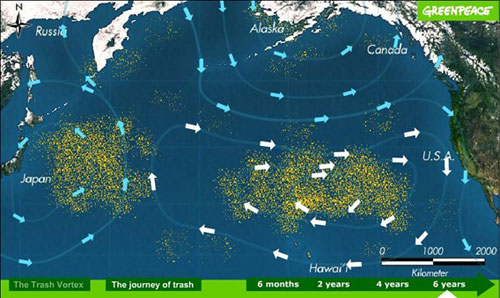
Plastic Continent: What is the North Pacific Garbage Patch
The Plastic Continent is also referred to as the North Pacific Garbage Patch. Nicknamed “the seventh continent” or “the trash continent”, the gigantic plastic dump that evolves between Hawaii and California was discovered in 1997. Since then, this ocean of plastic has been observed, analyzed but above all feared by the scientific community, because it just gets bigger.
Northeast of the Pacific, a mask and a snorkel are enough to contemplate the tragedy better known as the “seventh continent”. Those who have seen it during expeditions or studies evoke with disgust a soup of waste. An impressive underwater snowstorm where the flakes, micro-particles of plastic, bottles, packaging, fishing nets… do not melt.
How big is the 7th plastic continent
The trash vortex does not look like a floating island made of compacted garbage as one might imagine. It is more diffuse, moving, perverse. But one thing is certain, the Great Pacific Garbage Patch, as it is scientifically named, is currently the most polluted ocean area on the planet. And the largest because according to the latest figures, it would indeed extend over more than 1.6 million km2!
Who discovered the continent of plastic
The first explorer of this continent-trash was Charles J. Moore. In 1997, this American oceanographer was returning on a sailboat from a sea race with his team when he came across miles and miles of waste in the open sea, a sad sight. Day after day I saw no dolphins, no whales, no fish, I only saw plastic, he recalls.
This question then arises: why does all the rubbish seem to be concentrated there, and not near the coast or even further offshore? The answer will be quickly found: it is due to what are called oceanic gyres.
What is an ocean gyre
Imagine an underwater cyclone and you have the idea of the monster. Ocean gyres are areas where different ocean currents converge on each other and where huge permanent eddies form. By continually turning on themselves, these whirlpools trap in their center all that is brought back by the different currents. This creates an uncontrollable waste management issue
On the globe, there are five main gyres: two in the Atlantic, two in the Pacific and one in the Indian Ocean. That of the North Pacific is the most important. In 2018, it contained an estimated 80,000 tons of waste, a pile of more than 1.8 billion pieces of plastic. But since then, everything suggests that the 7th continent has grown exponentially, fueled by the continuous flows of waste dumped mainly by rivers.
Where does the plastic in the ocean garbage vortices come from
Similar plastic whirlpools are found in the South Pacific, the North and South Atlantic, and the Indian Ocean. There are also point eddies in the Mediterranean Sea.
Globally, scientists estimate the amount of plastic floating in the oceans at 7 million tons. 80% of this waste would be transported from the land by the wind or waterways. The remaining 20% would be waste discarded or fallen from merchant ships.
What is the impact of these whirlwinds of garbage on marine fauna
Plastic vortices pose a major threat to marine biodiversity: plastic, which takes hundreds of years to degrade, is fragmented by solar radiation and can thus be easily ingested by fish, birds, and mammals sailors, like dolphins.
How to protect the oceans from these plastic vortices
The cleaning of existing vortices is a colossal undertaking that no State is ready to take on, as these vortices are often outside their territorial waters. Even though a lot of this waste could be recycled, it is a hard task to take on. To prevent the appearance of new vortices, or at least control the size of the vortices already formed, it would be necessary to reduce the production and use of plastic, promote recycling, and use biodegradable plastic.
Plastic continent: a solution that is slow in coming
Trash vortices are disastrous for the planet and biodiversity. Confused with plankton, microplastics are ingested by fish, turtles, crustaceans… The entire marine world is impacted.
If the awareness is there, if waste management and dumpster rental companies (check this website), foundations, NGOs are committed to cleaning the gyres with boats, nets or any other innovation, the results are not yet up to the challenge. Apart from a global upsurge of governments and citizens, a change in consumption patterns and the end of single-use plastics, we wonder what could stop the machine.
In any case, if nothing changes, according to Peter Thomson, the current United Nations special envoy for the oceans, there will be as much plastic as fish in the seas of the globe by 2050.
